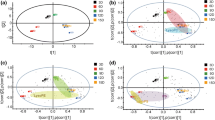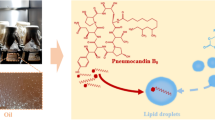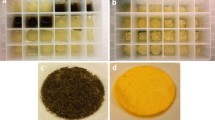Abstract
Cephalosporium acremonium has been widely applied in industrial cephalosporin C fermentation. However, little is known about the molecular basis of fermentation behavior of this strain. In this study, comparative lipidomic analysis using LC/ESI/MSn technology was employed to investigate responses of Cephalosporium acremonium to multiple environment variations in realistic industrial cephalosporin C fermentation process and provide molecular basis for the discrepancies between industrial and pilot fermentations. Totally 77 phospholipids species were detected and 65 species were further quantified. Score plot revealed that phospholipids metabolism differed in industrial and pilot process. Loading pilot indicated that the main variables responsible for the discrimination of industrial and pilot process were phosphatidylinositols (PIs), phosphatidylserines (PSs) and phosphatic acids (PAs). Higher PIs content in industrial process indicated that cells were more vigorous in industrial process than those in pilot process. Larger increases of PSs, PAs and ratio of oleic acid to linoleic acid coincided well with the earlier and more thorough cellular morphological differentiation in industrial process. The synergetic reaction between cellular behavior and cells living environment led to titer discrepancies between industrial and pilot process. These findings provided lipidomic insights into industrial cephalosporin C production.
Similar content being viewed by others
References
Cao, Y. X., B. Qiao, H. Lu, Y. Chen, and Y. J. Yuan (2011) Comparison of the secondary metabolites in Penicillium chrysogenum between pilot and industrial penicillin G fermentations. Appl. Microbiol. Biotechnol. 89: 1193–1202.
Junker, B., A. Walker, M. Hesse, M. Lester, D. Vesey, J. Christensen, B. Burgess, and N. Connors (2009) Pilot-scale process development and scale up for antifungal production. Bioproc. Biosyst. Eng. 32: 443–458.
Zhang, J. and A. L. Demain (1992) Regulation of ACV synthetase activity in the beta-lactam biosynthetic pathway by carbon sources and their metabolites. Arch. Microbiol. 158: 364–369.
Kim, J. H., J. S. Lim, and S. W. Kim (2004) The improvement of cephalosporin C production by fed-batch culture of Cephalosporium acremonium M25 using rice oil. Biotechnol. Bioproc. Eng. 9: 459–464.
Paul, S., R. Bezbaruah, R. Prakasham, M. Roy, and A. Ghosh (1997) Enhancement of growth and antibiotic titre in Cephalosporium acremonium induced by sesame oil. Folia Microbiol. (Praha). 42: 211–213.
Chae, K. I. M. J., S. W. O. O. Kang, J. S. O. O. Lim, Y. S. Song, and S. W. Kim (2006) Stimulation of cephalosporin C production by Acremonium chrysogenum M35 with fatty acids. J. Microbiol. Biotechnol. 16: 1120–1124.
Kim, J. C., Y. S. Song, D. H. Lee, S. W. Kang, and S. W. Kim (2007) Fatty acids reduce the tensile strength of fungal hyphae during cephalosporin C production in Acremonium chrysogenum. Biotechnol. Lett. 29: 51–55.
Martin, J. F. and A. L. Demain (2002) Unraveling the methionine-cephalosporin puzzle in Acremonium chrysogenum. Trends Biotechnol. 20: 502–507.
Zhou, W., K. Holzhauer-Rieger, M. Dors, and K. Schugerl (1992) Influence of dissolved oxygen concentration on the biosynthesis of cephalosporin C. Enzy. Microb. Technol. 14: 848–854.
Kim, J. C., J. S. Lim, J. M. Kim, C. Kim, and S. W. Kim (2005) Relationship between morphology and viscosity of the main culture broth of Cephalosporium acremonium M25. Korea-Australia Rheol. J. 17: 15–20.
Lee, H. H., Y. S. Song, J. Y. Lee, H. W. Jung, and S. W. Kim (2010) Rheological properties of culture broth of Acremonium chrysogenum M35 in baffled flasks with glass beads. Korea-Australia Rheol. J. 22: 51–58.
Lee, M. S., J. S. Lim, C. H. Kim, K. K. Oh, S. I. Hong, and S. W. Kim (2001) Effects of nutrients and culture conditions on morphology in the seed culture of Cephalosporium acremonium ATCC 20339. Biotechnol. Bioproc. Eng. 6: 156–160.
Russell, N. J., R. I. Evans, P. F. terSteeg, J. Hellemons, A. Verheul, and T. Abee (1995) Membranes as a target for stress adaptation. Int. J. Food Microbiol. 28: 255–261.
Beltran, G., M. Novo, J. M. Guillamon, A. Mas, and N. Rozes (2008) Effect of fermentation temperature and culture media on the yeast lipid composition and wine volatile compounds. Int. J. Food Microbiol. 121: 169–177.
Bhagyalakshmi, A., F. Berthiaume, K. Reich, and J. Frangos (1992) Fluid shear stress stimulates membrane phospholipid metabolism in cultured human endothelial cells. J. Vasc. Res. 29: 443–449.
Skorko-Glonek, J., B. Lipinska, K. Krzewski, G. Zolese, E. Bertoli, and F. Tanfani (1997) HtrA heat shock protease interacts with phospholipid membranes and undergoes conformational changes. J. Biol. Chem. 272: 8974–8982.
Verkleij, A., B. De Kruyff, P. Ververgaert, J. Tocanne, and L. Van Deenen (1974) The influence of pH, Ca2+ and protein on the thermotropic behaviour of the negatively charged phospholipid, phosphatidylglycerol. Biochim. Biophys. Acta Biomembr. 339: 432–437.
Hosono, K. (1992) Effect of salt stress on lipid composition and membrane fluidity of the salttolerant yeast Zygosaccharomyces rouxii. J. Gen. Microbiol. 138: 91–96.
Sohn, Y. S., K. C. Lee, Y. H. Koh, and G. H. Gil (1994) Changes in cellular fatty acid composition of Cephalosporium acremonium during cephalosporin C production. Appl. Environ. Microbiol. 60: 947–952.
Papacharilaou, E. and M. A. Pisano (1984) Changes in the lipid composition of Paecilomyces persicinus P-10 M1 during growth and cephalosporin C production. Appl. Environ. Microbiol. 48: 1084–1087.
Xia, J. M. and Y. J. Yuan (2009) Comparative lipidomics of four strains of Saccharomyces cerevisiae reveals different responses to furfural, phenol, and acetic acid. J. Agric. Food Chem. 57: 99–108.
Yang, S., S. H. Lu, and Y. J. Yuan (2008) Lipidomic analysis reveals differential defense responses of Taxus cuspidata cells to two elicitors, methyl jasmonate and cerium (Ce4+). Biochim. Biophys. Acta, Mol. Cell Biol. Lipids 1781: 123–134.
Sandor, E., A. Szentirmai, G. C. Paul, C. R. Thomas, I. Pocsi, and L. Karaffa (2001) Analysis of the relationship between growth, cephalosporin C production, and fragmentation in Acremonium chrysogenum. Can. J. Microbiol. 47: 801–806.
Holub, B. J. (1986) Metabolism and function of myo-inositol and inositol glycerophospholipids. Annu. Rev. Nutr. 6: 563–597.
Ishii, I., N. Fukushima, X. Q. Ye, and J. Chun (2004) Lysophospholipid receptors: Signaling and biology. Annu. Rev. Biochem. 73: 321–354.
Hoffmann, P. R., A. M. DeCathelineau, C. A. Ogden, Y. Leverrier, D. L. Bratton, D. L. Daleke, A. J. Ridley, V. A. Fadok, and P. M. Henson (2001) Phosphatidylserine (PS) induces PS receptormediated macropinocytosis and promotes clearance of apoptotic cells. J. Cell Biol. 155: 649–660.
Mykytczuk, N., J. Trevors, L. Leduc, and G. Ferroni (2007) Fluorescence polarization in studies of bacterial cytoplasmic membrane fluidity under environmental stress. Prog. Biophys. Mol. Biol. 95: 60–82.
Sandermann Jr, H. (1978) Regulation of membrane enzymes by lipids. Biochim. Biophys. Acta 515: 209–237.
Los, D. A. and N. Murata (2004) Membrane fluidity and its roles in the perception of environmental signals. Biochim. Biophys. Acta Biomembr. 1666: 142–157.
Boumann, H. A., M. J. A. Damen, C. Versluis, A. J. R. Heck, B. de Kruijff, and A. de Kroon (2003) The two biosynthetic routes leading to phosphatidylcholine in yeast produce different sets of molecular species. Evidence for lipid remodeling. Biochem. 42: 3054–3059.
Bankaitis, V. A. and A. J. Morris (2003) Lipids and the exocytotic machinery of eukaryotic cells. Curr. Opin. Cell Biol. 15: 389–395.
Gruner, S. M. (1985) Intrinsic curvature hypothesis for biomembrane lipid composition: a role for nonbilayer lipids. Proc. Natl. Acad. Sci. USA. 82: 3665–3669.
Li, Z., L. B. Agellon, T. M. Allen, M. Umeda, L. Jewell, A. Mason, and D. E. Vance (2006) The ratio of phosphatidylcholine to phosphatidylethanolamine influences membrane integrity and steatohepatitis. Cell. metab. 3: 321–331.
Clarke, S. D. (2001) Polyunsaturated fatty acid regulation of gene transcription: A molecular mechanism to improve the metabolic syndrome. J. Nutr. 131: 1129–1132.
Lim, J. S., J. H. Kim, C. Kim, and S. W. Kim (2002) Morphological and rheological properties of culture broth of Cephalosporium acremonium M25. Korea-Australia Rheol. J. 14: 11–16.
Pazouki, M. and T. Panda (2000) Understanding the morphology of fungi. Bioproc. Biosyst. Eng. 22: 127–143.
Author information
Authors and Affiliations
Corresponding author
Rights and permissions
About this article
Cite this article
Xu, RJ., Qiao, B., Li, BZ. et al. Comparative lipidomic analysis of Cephalosporium acremonium insights into industrial and pilot fermentations. Biotechnol Bioproc E 17, 259–269 (2012). https://doi.org/10.1007/s12257-011-0494-8
Received:
Revised:
Accepted:
Published:
Issue Date:
DOI: https://doi.org/10.1007/s12257-011-0494-8




